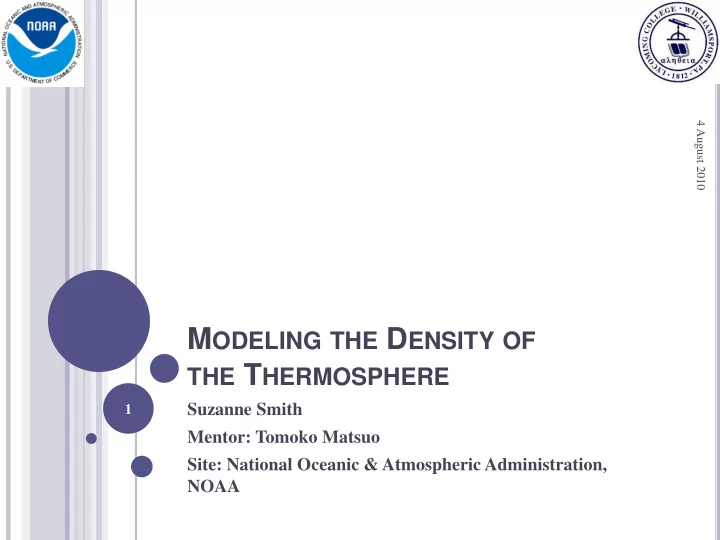

4 August 2010 M ODELING THE D ENSITY OF THE T HERMOSPHERE Suzanne Smith 1 Mentor: Tomoko Matsuo Site: National Oceanic & Atmospheric Administration, NOAA
E ARTH ’ S A TMOSPHERE 4 August 2010 2
I MPORTANCE OF M ODELING THE T HERMOSPHERE 4 August 2010 Height of satellites and space shuttles orbit. The neutral density of the thermosphere effects the amount of drag present. With increased density and drag the shuttles and satellites are slowed and the orbiting altitude is decreased. Having an efficient and accurate model of thermospheric density is a valuable asset. 3
I NTRODUCTION 4 August 2010 General Circulation Model, GCM Previous work CTIPe model: The Coupled Thermosphere Ionosphere Plasmasphere Electrodynamics Model, Tim Fuller-Rowell et al. 1996 Global Thermosphere 80-500km: solves momentum, energy, composition Ionosphere 80-10,000km: solves continuity, momentum, energy, etc. Forcing: solar UV and EUV, empirical high latitude electric field and auroral precipitation models, tidal forcing. CHAMP Satellite: Challenging Minisatellite Payload Satellite height~ 400km; 90min orbital period; Launched date: July 2000. 2005 CTIPe 5-min Run, Mariangel Fedrizzi 4
4 August 2010 5 M. Fredrizzi, et al. 2009
I NTRODUCTION , CONT . 4 August 2010 My Work Used multi-dimensional GCM (CTIPe) output and reduced it to a low-dimension model. Specifically, conducted Singular Value Decomposition (SVD) Analysis of CTIPe 5-min model output from 2005, and constructed a model of thermospheric density. Density in terms of position and time: (r, t) = 1 (r) 1 (t) + 2 (r) 2 (t) + .. + n (r) n (t) n (r) = EOF n (t) = Amplitude 6
D RIVERS OF D ENSITY C HANGE 4 August 2010 Extreme Ultra Violet(EUV) Diurnal Seasonal Solar wind/Magnetosphere Interactions Auroral Activity 7
Y EAR M EAN & EOF A MPLITUDE V ARIANCE 4 August 2010 8
Y EARS WORTH OF E MPIRICAL O RTHOGANAL F UNCTIONS (EOF S ), 4 August 2010 9
EOF A MPLITUDES , 4 August 2010 10
M ODE #1: D IURNAL EUV 4 August 2010 Caused by the earth’s daily rotation. The day side’s density increases because of the increased EUV. August 2005 11
M ODE #2: S EASONAL EUV 4 August 2010 12
M ODE #2: S EASONAL EUV CONT . 4 August 2010 Caused by the earth’s yearly revolution around the sun. In our summer months the northern hemisphere is pointed towards the sun which results in a greater amount of EUVs. Winter‘05 Summer ‘05 13
M ODE #3: A URORAL A CTIVITY 4 August 2010 Cause by high latitude electromagnetic forcing resulted from the interaction between Solar Wind and the earth’s magnetosphere (i.e., auroral activity). Aurora occur both in the Northern and Southern hemisphere creating a symmetric pattern in the EOF contour plots. Oct 2005 14
R ESOURCES : D RIVERS OF D ENSITY C HANGE 4 August 2010 Ap Index (Kyoto): A measure of the level of geomagnetic activity over the globe taken every 3hrs. Solar Wind (NASA OMNIWeb): collection of different data sets that help to display storm conditions. Joule Heating (CTIPe Model): integrated over the globe F 10.7 (Ottawa 10.7cm flux): EUV index 15
P ROVING M ODE #3 IS A URORAL A CTIVITY 4 August 2010 F10.7 Ap Ap > 150 EOF 1 0.5163 0.4411 0.3068 EOF 2 0.0410 0.0345 0.2714 EOF 3 0.0388 0.0097 0.2548 EOF 4 0.6221 0.0364 0.3659 Correlating the different EOFs with EUV Index: F10.7 (daily value), and Geomagnetic Index: Ap (taken every three hours). Surprising lack of correlation between Ap and EOF3. 16
A UGUST 24 TH : S OLAR W IND D ATA (OMNI) 4 August 2010 B-field Proton Density Solar Wind Speed Dst Index 17 Ap Index
A UGUST 24 TH : A P I NDEX & J OULE H EATING 4 August 2010 18
A UGUST 24 TH : T HERMOSPHERIC D ENSITY R ECONSTRUCTION USING EOF S 4 August 2010 19
F INISHED P RODUCT 4 August 2010 20
A CKNOWLEDGEMENTS 4 August 2010 Tomoko Matsuo, mentor Mariangel Fredrizzi, officemate & CTIPe Data Timothy Fuller-Rowell, CTIPe model & mentoring Rodney, dark chocolate covered acia berries Doug Biesecker Mike Crumly, vouching for me Russ Henson, technology help National Oceanic & Atmospheric Administration, NOAA Space Weather Prediction Center, SWPC MatLab 21
R EFERENCE 4 August 2010 NOAA Crest, http://www.thebradentontimes.com/clientuploads/webpages/n oaa-logo.jpg. Lycoming Crest, http://upload.wikimedia.org/wikipedia/en/thumb/1/1d/Lycomi ng_College_logo.png/175px-Lycoming_College_logo.png. Earth’s Atmosphere, http://www.vtaide.com/png/images/atmosphere.jpg. CHAMP & CTIPe data plot, Mariangel Fredrizzi, et al. Ap Index, http://wdc.kugi.kyoto-u.ac.jp/kp/index.html. Solar Wind Data, NASA OMNIWeb, http://omniweb.gsfc.nasa.gov/ Joule Heating, CTIPe Model F 10.7, Daily F 10.7 index, the Ottawa 10.7cm (2800 MHz) 22 radio flux
4 August 2010 Q UESTIONS ? 23
Recommend
More recommend